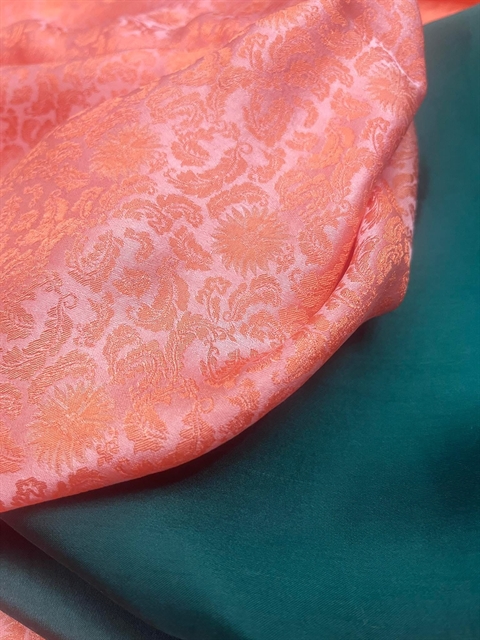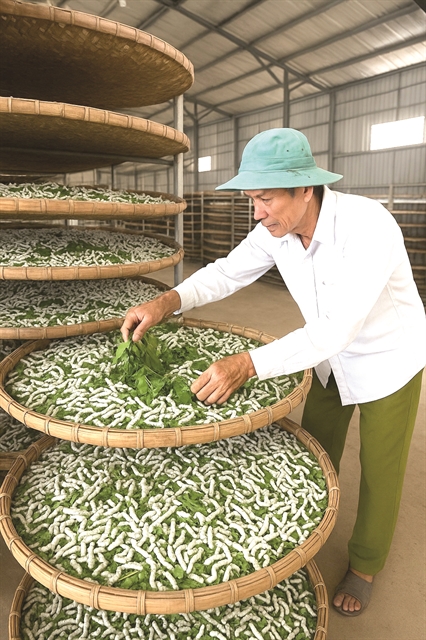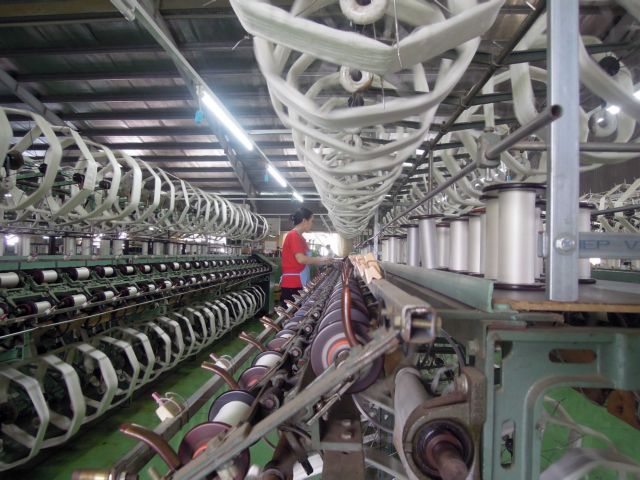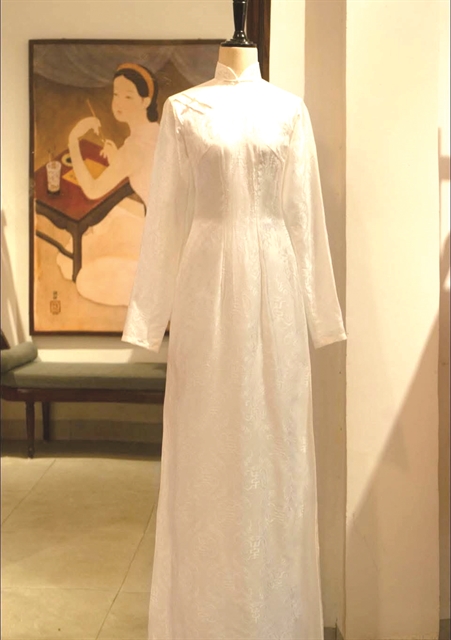Weather:
- Ha Noi 26oC
- Da Nang 28oC
- Ho Chi Minh 29oC
Văn Châu

In the Central Highlands province of Lâm Đồng, the traditional silk craft is being carefully preserved and steadily revived in Bảo Lộc, as farmers, handicraft people and investors work hand in hand to weave a future where tradition and modern industry thrive together.
Perched in the misty highlands, Bảo Lộc has long been known as Việt Nam’s “capital of sericulture".
For generations, the town’s temperate climate and fertile red soils have nurtured vast fields of mulberry, whose leaves are feed for silkworms that spin cocoons of shimmering fibre for silk fabric.
The craft, however, almost unravelled. By the late 20th century, economic shifts pushed farmers toward cash crops like coffee and tea. Imported silk and synthetic fibres flooded the market.
Many workshops fell silent; the younger generation sought work in cities. By the early 2000s, Bảo Lộc’s once-thriving sericulture industry had shrunk to a shadow of its former self.
The seeds of revival
The tide began to turn in the 2010s, when rising silk cocoon prices, renewed interest in handmade fabrics, and targeted government programmes converged.
Pilot projects introduced improved mulberry varieties and disease-resistant silkworm strains. Cooperative farming models started to rebuild trust among mulberry growers, silkworm rearers and silk weavers.
One early champion of this resurgence was Hà Thị Hoa, director of Hà Bảo Silk Reeling and Weaving Co Ltd.
She remembered the leap of faith required to reinvest in traditional sericulture: “To go far, we must preserve the soul of traditional silk—purely natural—while improving technique and technology,” she said.
She took loans to buy and repair reeling machines, betting on quality over quick returns.
That gamble would pay off as Bảo Lộc’s brand name began to reappear at national craft fairs and in export orders.
Another key figure, Huỳnh Tấn Phước, chairman of Nhật Minh Silk Co Ltd, recalled scavenging broken machines to keep production alive.
“Technical competence and patient investment are the bridge between our craft and international markets,” he said. His workshop now supplies finished silk to designers in Europe and Asia, a far cry from the days of barely meeting local demand.

The heart of the loom
While business leaders chart strategies, farmers remain the foundation of the silk industry. In Đà Loan Village, Nguyễn Tầm Hồng and Trần Minh Phượng have been tending mulberry fields and silkworms since 1985. The early years were far from easy.
“To earn a living from this craft was a real challenge. Techniques were rudimentary, and broodstock often unreliable,” Hồng recalled.
Even now, challenges persist. Rising input costs, unpredictable weather patterns, and occasional pest outbreaks can wipe out weeks of labour.
“When the rains come too early or too heavily, the mulberry leaves lose their quality, and the worms suffer,” Phượng explained.
Access to affordable credit remains another hurdle, making it difficult to expand production or invest in new equipment.
Today, with improved sanitation, controlled temperatures, and better ventilation in rearing rooms, their 2,000-square-metre smallholding yields up to two boxes of cocoons each cycle, providing a stable income.
This transformation has persuaded younger family members to stay and work the land.
But both Hồng and Phượng hope for more targeted support from local authorities—such as subsidised loans, training programmes on disease prevention, and guaranteed purchase prices—to secure the craft’s future.
“We’re no longer just surviving—we’re living from this work, but to keep the tradition strong, we need the next generation to see a future in it,” Phượng said.
Artisans are the custodians of Bảo Lộc’s most precious asset: the weaving techniques passed through generations.
Nguyễn Trung Hiếu, a master weaver, described blending old and new: “We combined the dexterity handed down by our grandparents with modern cultivation and rearing methods. That’s how the silk regained its lustre and consistency.”
For designer Minh Hạnh, who has championed Vietnamese silk fashion on global catwalks, the mission is clear: “Traditional silk is our heritage. To sustain it, we must connect it to Vietnamese brand development. Through fashion, we carry the silk’s legacy forward vividly and authentically.”
Her efforts have included fashion shows abroad and the creation of Vietnam Silk House, a collective aimed at building recognition for Bảo Lộc silk as a cultural brand, not just a material.

Government, a silent partner
Lâm Đồng authorities have played a strategic role in the silk industry’s revival, acting less as a commanding force and more as a steady hand guiding its course.
Their plan to 2030 emphasises sustainable mulberry-growing zones, standardised silkworm rearing practices, and modern wastewater treatment systems for dye houses—measures designed not only to protect the environment but also to align production with international quality benchmarks.
Subsidised loans and vocational training have enabled small-scale producers to upgrade reeling machines, improve cocoon drying facilities, and meet the stringent environmental standards demanded by export markets.
Training programmes, often conducted in partnership with industry associations, provide artisanal sericulturists with updated weaving techniques, pest management skills, and knowledge on natural dyeing methods.
Periodic workshops bring together farmers, reelers, and designers to exchange expertise, troubleshoot challenges, and explore new market opportunities.
Local authorities have also invested in brand-building—registering geographical indications, creating unified quality labels, and promoting Bảo Lộc silk at international fairs from Tokyo to Paris.
These events, alongside domestic trade shows and cultural festivals, have given small producers direct exposure to buyers and fashion houses, reducing reliance on intermediaries.
Financial incentives, such as tax relief for eco-friendly production facilities and preferential interest rates for cooperative groups, aim to encourage sustainable practices and capital investment.
Yet for many farmers and artisans, the relationship with the government is one of cautious optimism.
While grateful for existing programmes, they see room for deeper collaboration—more direct market access, swifter disbursement of funds, and tailored technical support to address local climate and pest disease challenges.

Silk on world stage
Bảo Lộc silk has started to attract attention abroad.
At a recent showcase in Moscow, Phước watched visitors run their fingers along bolts of silk in intricate patterns.
One Russian attendee, Elena, remarked: “I was deeply impressed. I had visited Việt Nam and your traditional silk craft gave me deeper cultural insight… these fabrics enchant.”
Another visitor said: “The quality is remarkable and unique.” These encounters have opened talks for Bảo Lộc silk showrooms in Russia and Europe.
The push for recognition goes beyond export volumes.
As Minh Hạnh warned: “If we stay merely as contractors, Bảo Lộc remains invisible—even to Vietnamese. We must assert our heritage on the world’s map.”
This means investing in storytelling—each scarf or áo dài (traditional long dress) carries not just silk, but the narrative of highland mists, mulberry leaves, and the patient care of sericulturists.
Designers and producers are experimenting with natural dyes, eco-friendly packaging, and limited-edition runs that appeal to high-end markets.

Remaining knots to untangle
Challenges persist for Bảo Lộc’s silk industry. Many farms remain small and scattered, making it difficult to invest in large-scale mechanisation.
The quality of silkworms varies from farm to farm, and access to credit is still a hurdle as banks remain cautious about financing traditional craft enterprises.
Labour shortages are an ongoing concern as younger generations weigh the lure of urban employment against rural livelihoods.
Adding to these pressures is the unpredictability brought by climate change, which can disrupt mulberry yields and silkworm-rearing cycles.

Industry leaders agree that the revival of Bảo Lộc silk must be built on co-operation, modernisation, branding, and the training of new artisans.
Strengthening links between farmers and manufacturers will help stabilise raw material supply, while the adoption of improved machinery can raise efficiency and meet global standards.
Equally important is the creation of a unified brand identity that positions Bảo Lộc silk as a premium product imbued with cultural heritage. Passing down skills to younger generations ensures that the knowledge does not fade away with time.
Investment is already flowing from both domestic and overseas partners, encouraged by the combination of tradition and adaptability that Bảo Lộc offers.
For many stakeholders, the vision is to see the silk industry stand proudly alongside the world’s most renowned producers, while remaining rooted in the cool highlands where it began.
As Director Hoa reflects: “We are not just weaving silk—we are weaving the future of our town. Every thread carries the hopes of those who came before, and the promise to those yet to come.” VNS

